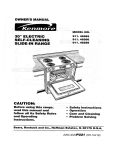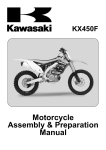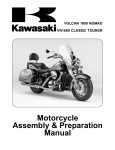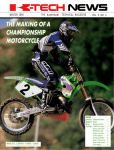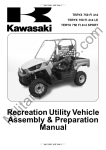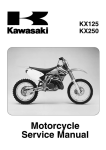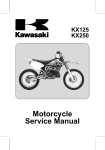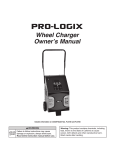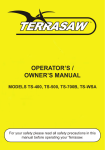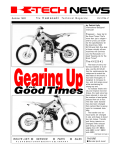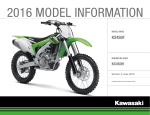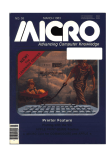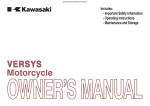Download Motorcycle Assembly & Preparation Manual
Transcript
KX250 Motorcycle Assembly & Preparation Manual Foreword In order to ship Kawasaki vehicles as efficiently as possible, they are partially disassembled before crating. Since some of the most commonly removed parts have a direct bearing on a vehicle’s reliability and safety, conscientious pre-sale assembly and preparation becomes extremely important. Good setup procedures can prevent needless warranty claims and give customers a greater sense of confidence in Kawasaki and their Kawasaki Dealers. This Assembly and Preparation Manual explains step by step procedures of the following items for the Kawasaki KX250. 1. Uncrating 2. Assembly 3. Preparation The selling dealer assumes sole responsibility for any unauthorized modifications prior to sale. Refer to your Service Binder for any Service Bulletins specifying Factory Directed Modifications (Special Claims) which must be performed before the vehicle is ready for sale. Whenever you see the following symbols heed their instructions! Always follow safe operating and maintenance practices. © 2006 Kawasaki Heavy Industries, Ltd. WARNING This warning symbol identifies special instructions or procedures which, if not correctly followed, could result in personal injury, or loss of life. CAUTION This caution symbol identifies special instructions or procedures which, if not correctly followed, could result in damage to, or destruction of equipment. NOTE ○This note symbol indicates points of particular interest for more efficient and convenient operation. Kawasaki Heavy Industries, Ltd. accepts no liability for any inaccuracies or omissions in this publication, although every possible measure has been taken to make it as complete and accurate as possible. All procedures and specifications subject to change without notice. July, 2006 Table of Contents Uncrating ...................................................................................... Opening Crate ............................................................................. Parts Check ................................................................................. Assembly ...................................................................................... Handlebar (KX250-R1 Only) ....................................................... Handlebar (KX250R6F/R7F Only)............................................... Throttle Grip Assembly (KX250-R1 Only) ................................... Throttle Grip Assembly (KX250R6F/R7F Only)........................... Front Brake Master Cylinder (KX250-R1 Only) ........................... Front Brake Master Cylinder (KX250R6F/R7F Only) .................. Clutch Lever Assembly (KX250-R1 Only) ................................... Clutch Lever Assembly (KX250R6F/R7F Only) .......................... Engine Stop Switch (KX250-R1 Only) ......................................... Engine Stop Switch (KX250R6F/R7F Only) ................................ Front Fender................................................................................ Front Wheel Assembly (KX250-R1 Only) .................................... Front Wheel Assembly (KX250R6F/R7F Only) ........................... Front Wheel Installation............................................................... Front Number Plate ..................................................................... Fuel Tank Vent Hose ................................................................... Side Stand................................................................................... Brake Disc Cleaning .................................................................... Preparation ................................................................................... Air Cleaner ................................................................................. Front Brake Fluid......................................................................... Rear Brake Fluid ......................................................................... Clutch Lever and Cable ............................................................... Drive Chain.................................................................................. Front Fork .................................................................................... Rear Shock Absorber .................................................................. Tire Air Pressures........................................................................ Fuel ............................................................................................. Coolant ........................................................................................ Transmission Oil.......................................................................... Throttle Grip and Cable ............................................................... Fastener Check ........................................................................... Standard Torque Table ................................................................ Test Ride the Motorcycle ............................................................. A&P Check List ........................................................................... 3 3 4 8 8 9 10 10 11 11 11 12 12 12 12 13 13 14 15 15 16 16 16 16 17 19 20 20 21 23 25 25 25 26 27 30 31 32 32 UNCRATING 3 Uncrating Opening Crate a space about 6 m (20 ft.) square to • Clear give yourself plenty of space to work. the crate upright on its base. • Place Remove cardboard cover. • Unfastenthe the bands securing the front wheel • assembly to the crate and remove it. Remove the handlebar, front wheel, and the • parts box. CAUTION When removing the crate bracket from the motorcycle, be careful not to drop any parts or the bracket onto the fuel tank and other components, and not to scratch the fuel tank or other components with the crate bracket. the crate bolts (D = 8, L = 14) to take • Remove off the crate bracket and discard them. A. Crate Bolts (D = 8, L = 14) B. Crate Bracket out all the bolts and screws and remove • Take the top and sides of the crate. 4 UNCRATING Parts Check the parts box, and check the parts • Open against the illustrations. There may be minor differences between these illustrations and the actual vehicle parts. In the following charts under Remarks, D = diameter in millimeters, and L = length in millimeters. KX250-R1 No. 1 2 3 4 Part Name Handlebar with Grip Handlebar Clamp Clamp Bolt, Flanged Clamp, Master Cylinder Clamp Bolt, Master Cylinder Clamp, Clutch Lever Clamp Bolt with Washer Screw, Engine Stop Switch Clamp, Engine Stop Switch Wiring Band, Engine Stop Switch Lead Fuel Tank Vent Hose with Valve Front Wheel Front Axle Clamp Bolt, LH & RH Front Axle Nut Axle Collar, LH Axle Collar, RH Cap, Axle Collar Front Fender with Collars Flanged Bolt with Washers Front Number Plate Flanged Bolt with Washer, Number Plate Stand, Side Tool, Wrench, Spark Plug Tool, Wrench, Spoke Nipple Owner’s Manual Qty 1 1 4 1 2 1 2 1 2 1 1 1 3 1 1 1 2 1 4 1 1 1 1 1 1 Remarks D = 8, L = 30 D = 6, L = 22 D = 5, L = 16 D=3 L = 51.6 L = 370 D = 8, L = 40 D = 18 L = 29 L = 19 Plastic D = 6, L = 20 D = 6, L = 12 UNCRATING 5 KX250R6F/R7F No. 1 2 3 4 Part Name Handlebar with Grip Handlebar Clamp Clamp Bolt, Flanged Handlebar Pad Clamp, Master Cylinder Clamp Bolt, Master Cylinder Clamp, Clutch Lever Clamp Bolt with Washer Screw, Engine Stop Switch Clamp, Engine Stop Switch Wiring Band, Engine Stop Switch Lead Fuel Tank Vent Hose with Valve Front Wheel Front Axle Clamp Bolt, LH & RH Front Axle Nut Axle Collar, LH & RH Cap, Axle Collar Front Fender with Collars Flanged Bolt with Washer Front Number Plate Flanged Bolt with Washer, Number Plate Stand, Side Tool, Wrench, Spark Plug Tool, Wrench, Spoke Nipple Owner’s Manual Qty 1 2 4 1 1 2 1 2 1 2 1 1 1 3 1 2 2 1 4 1 1 1 1 1 1 Remarks RENTHAL D = 8, L = 35 RENTHAL D = 6, L = 22 D = 5, L = 16 D=3 L = 100 L = 350 D = 8, L = 40 D = 18 L = 27.5 Plastic D = 6, L = 20 D = 6, L = 12 6 UNCRATING Spare Parts these spare parts to your customer(s) after none of those incorrect and/or defaults were • Provide securely reserved. These parts and their part numbers are subject to change without prior notice according to the model year. UNCRATING 7 No. 1 2 3 4 5 6 7 8 9 10 **10 11 12 13 14 15 *16 17 18 19 20 21 22 23 24 25 26 27 28 29 Part Name Gasket, Cylinder Base Gasket, Cylinder, Center Cover Gasket, Cylinder, RH Cover Gasket, Clutch Outside Cover Gasket, Water Pump Cover Gasket, Generator Cover Gasket, Valve Cover Gasket, Exhaust Pipe Gasket, Clutch Inside Cover Piston, Engine Piston, Engine Piston Pin Piston Ring Needle Bearing, Small End Front Brake Lever Jet Needle, NFUG 2.715 Wool, Muffler, L = 240, D = 31 Wool, Muffler, L = 310, D = 31 Rear Sprocket, 51T Clutch Lever Circlip, Piston Pin O-Ring, Cylinder Head, In O-Ring, Cylinder Head, Out O-Ring, Exhaust, 54MM O-Ring, Elbow, Water Pump, 19MM Main Jet, #158 Main Jet, #162 Main Jet, #170 Slow Jet, #52 Slow Jet, #48 *: Australian Models Only **: KX250R7F Models Only Qty 2 2 2 2 2 2 4 2 2 1 1 1 2 1 1 1 1 1 1 1 2 2 2 4 2 1 1 1 1 1 Part Number 11061-0091 11061-0092 11061-0093 11061-0095 11061-0097 11061-0098 11061-0138 11061-0142 11061-0144 13001-0028 13001-0058 13002-1098 13003-0029 13033-1010 13236-0070 16187-0163 18046-1599 18046-1397 42041-1451 46092-0007 92033-1336 92055-0049 92055-0050 92055-0052 92055-1308 92063-1367 92063-1369 92063-1372 92064-1130 92064-1143 8 ASSEMBLY Assembly Handlebar (KX250-R1 Only) 2-stroke oil on the throttle grip mounting • Apply area of the handlebar. a light coat of grease on the exposed • Apply portion of the throttle inner cable. the throttle grip dust cover and the grip • Slide onto the right-hand end of the handlebar. A. Handlebar Clamp B. Align the clamp slot with the handlebar bridge. C. C = D Handlebar Clamp Bolt Tightening the front bolts first, and then the rear • Tighten bolts to the specified torque. If the handlebar A. Throttle Grip B. Apply 2-stroke Oil the handlebar clamp on the handle• Position bar so that the marks of clamp point toward clamp is correctly installed, there will be no gap at the front and a gap at the rear after tightening. Torque : 25 N·m (2.5 kgf·m, 18 ft·lb) the rear. A. B. C. D. Handlebar Clamp Clamp Bolts Gap Marks A. Forward B. No Gap C. Gap ASSEMBLY 9 Viewed from Front: 1. 2. 3. 4. 5. Throttle Cable Wiring Band Engine Stop Switch Lead Clutch Cable Route the clutch cable and throttle cable above the front number plate bolt. A. Handlebar Clamps (Upper) B. Clamp Bolts C. Protrusion (C = D) E. Forward F. Handlebar Handlebar (KX250R6F/R7F Only) 2-stroke oil on the throttle grip mounting • Apply area of the handlebar. a light coat of grease on the exposed • Apply portion of the throttle inner cable. the throttle grip dust cover and the grip • Slide onto the right-hand end of the handlebar. A. Handlebar Clamp B. Align the center of the handlebar clamps with the handlebar bridge. C. Protrusion (C = D) E. Forward Handlebar Clamp Bolt Tightening the clamp bolts evenly and tighten • Tighten them to the specified torque. Make sure that A. Throttle Grip B. Apply 2-stroke Oil the handlebar on the lower handlebar • Set clamps so that the protrusion of graduation in • both sides shall be nearly equal, and install the upper handlebar clamps on the handlebar. Apply 2-stroke oil to the threads of the handlebar clamp bolts (D = 8, L = 35), and install the clamp bolts. there will be even gap on the front and rear side of the clamp after tightening. Torque : 25 N·m (2.5 kgf·m, 18 ft·lb) 10 ASSEMBLY A. Forward B. Even Gap Viewed from Front: A. B. C. D. Dust Cover Throttle Case Bolt Punched Mark WARNING Do not push the throttle grip so far onto the handlebar that the inside of the grip contacts the end of the handlebar. This can interfere with throttle action and could result in loss of control. 1. 2. 3. 4. 5. Throttle Cable Wiring Band Engine Stop Switch Lead Clutch Cable Route the clutch cable and throttle cable above the front number plate bolt. Throttle Grip (KX250R6F/R7F Only) Assembly the throttle cases with grip assembly • Position so that the parting line of the upper and lower throttle cases horizontally. Throttle Grip Assembly (KX250-R1 Only) the throttle grip assembly so that the • Position parting line of the upper and lower throttle • cases align with the punched mark on the handlebar, and tighten the mounting bolts securely with the dust cover slipped off. Open and close the throttle grip, and check for proper throttle operation. Install the dust cover. A. Throttle Case (Upper) B. Throttle Case (Lower) C. Position the Throttle Cases Parting Line Horizontally. D. Viewed Throttle Cases from Left Side. the mounting bolts securely with the • Tighten dust cover slipped off. and close the throttle grip, and check for • Open proper throttle operation. Install dust cover. ASSEMBLY 11 the upper clamp bolt first and then the • Tighten lower bolt to the specified torque. Torque : 8.8 N·m (0.90 kgf·m, 78 in·lb) Front Brake Master (KX250R6F/R7F Only) Cylinder the master cylinder with the clamp and • Install bolts (D = 6, L = 22) on the handlebar so that the master cylinder horizontally. A. B. C. D. E. Dust Cover Throttle Case (Upper) Throttle Case (Lower) Bolt Position the Throttle Cases Parting Line Horizontally. F. Viewed Throttle Cases from Left Side. WARNING Do not push the throttle grip so far onto the handlebar that the inside of the grip contacts the end of the handlebar. This can interfere with throttle action and could result in loss of control. Front Brake Master (KX250-R1 Only) A. Front Brake Master Cylinder B. 185 mm (7.3 in.) C. Horizontal Line the upper clamp bolt first and then the • Tighten lower bolt to the specified torque. Torque : 8.8 N·m (0.90 kgf·m, 78 in·lb) Cylinder the master cylinder with the clamps on • Install the handlebar. the master cylinder so that the ver• Position tical parting line of the front and rear master cylinder clamps align with the punched mark on the handlebar. A. Bolts (D = 6, L = 22) B. UP Mark Clutch Lever Assembly (KX250-R1 Only) A. Bolt (Upper) B. UP Mark C. Punched Mark the clutch lever with the clamps and • Install bolts (D = 5, L = 16) on the handlebar so that • the vertical parting line of the front and rear clutch lever clamps align with the punched mark on the handlebar. Tighten the clamp bolts. 12 ASSEMBLY A. Clutch Lever Assy and Dust Cover B. Bolt (D = 5, L = 16) C. Punched Mark Clutch Lever (KX250R6F/R7F Only) Assembly the clutch lever with the clamp and • Install bolts (D = 5, L = 16) on the handlebar as • shown. Tighten the clamp bolts. A. B. C. D. Engine Stop Switch Clamps Screw Wiring Band the engine stop switch lead to the handle• Fix bar with the wiring band (L = 51.6). Engine Stop (KX250R6F/R7F Only) Switch the engine stop switch and its clamps • Install between the grip and the clutch lever with the small screw and tighten it. A. Clutch Lever Assy B. 180 mm (7.1 in.) C. Bolts (D = 5, L = 16) D. Horizontal Line E. 20° ±5° Engine Stop Switch (KX250-R1 Only) the engine stop switch and its clamps • Install between the grip and the clutch lever with the small screw and tighten it. A. Engine Stop Switch B. Clamps C. Screw D. Wiring Band (L = 100) the engine stop switch lead to the handle• Fix bar with the wiring band (L = 100). Front Fender the crate bolts (D = 8, L = 30) to take • Remove off the crate bracket and discard them. ASSEMBLY 13 A. B. C. D. Crate Bolts (D = 8, L = 30) Crate Bracket Clamp Bolt (Right) Front Axle the motorcycle off the crate base and sup• Lift port the motorcycle with a suitable stand or • • • • jack to install the front fender and wheel. Discard the crate base. Loosen the right side axle clamp bolt and remove the front axle. The front fender has four inserted collars. Position the front fender between the fork legs and fasten it to the steering stem bracket with four bolts (D = 6, L = 20). A. B. C. D. Longer Collar Caps Shorter Collar Apply Grease the longer collar (L = 29) and cap on • Install the left side of the hub, and the shorter collar (L = 19) and cap on the right side. A. Axle Clamp Bolts (left) B. Longer Collar (left) C. Cap install the front axle clamp bolts (D = • Loosely 8, L = 40) (3). A. Front Fender B. Bolts (D = 6, L = 20) Front Wheel Assembly (KX250-R1 Only) Axle Collar: ○Fit the projection on the cap to the groove on Assembly Axle Collar: NOTE ○Fit the projection on the cap to the groove on each collar. NOTE each collar. Front Wheel (KX250R6F/R7F Only) 14 ASSEMBLY A. Collars (L = 27.5) B. Caps C. Apply Grease the axle collars (L = 27.5) and caps on both • Fit sides of the front wheel hub. The collars are identical. A. Front Axle B. Collar C. Clamp Bolts (Right) D. Front Axle Nut E. Clamp Bolts (Left) F. Collar tighten the left side axle clamp bolts • Gradually to the specified torque. Front Axle Clamp Bolt Torque: 20 N·m (2.0 kgf·m, 14 ft·lb) NOTE ○Tighten the two axle clamp bolts alternately two times to ensure even tightening torque. tightening the right side axle clamp • Before bolts, pump the front fork up and down 4 or A. Axle Clamp Bolts (Left) B. Collar (L = 27.5) C. Cap install the front axle clamp bolts (D = • Loosely 8, L = 40) (3). Front Wheel Installation 5 times to align the right front fork leg and to seat the front axle. Do not pull the brake lever when pumping the fork. ○Do NOTE not apply the front brake during this process to stop the motorcycle from rolling forward. Put a block in front of the front wheel to stop moving. the front wheel assembly between the • Put fork legs. the front brake disc into the front brake • Insert pads. the front axle from the right side of the • Insert vehicle and install the front axle nut. • Tighten the axle nut to the specified torque. Front Axle Nut Torque: 79 N·m (8.0 kgf·m, 58 ft·lb) A. Pump the fork up and down. B. Block ASSEMBLY 15 tighten the right side axle clamp • Gradually bolts to the specified torque. Front Axle Clamp Bolt Torque: 20 N·m (2.0 kgf·m, 14 ft·lb) NOTE ○Tighten the two front axle clamp bolts alternately two times to ensure even tightening torque. WARNING Do not attempt to ride the motorcycle until a full brake lever is obtained by pumping the brake lever until the pads are against the disc. The brake will not function on the first application of the lever if this is not done. Front Number Plate the front number plate between the • Position brake hose and the front fork, and fit the two A. B. C. D. Front Number Plate Bolt (D = 6, L = 12) Clutch Cable Throttle Cable Handlebar Pad (KX250R6F/R7F Only) Installation attach the belt, install the handlebar • Before pad onto the handlebar bridge as shown. projections on the number plate into the holes in the steering stem bracket. A. Handlebar Pad the number plate belt to the handlebar • Attach pad and latch the belt. A. Front Number Plate B. Projection C. Hole the clutch cable and throttle cable • Route above the front number plate bolt as show. the number plate to the stem head • Fasten with the flanged bolt (D = 6, L = 12) and attach the belt to the handlebar bridge and latch the belt. Fuel Tank Vent Hose the shorter hose end of the vent hose into • Fit the fuel tank cap, making sure the arrow on the valve points toward the cap. 16 PREPARATION A. Vent Hose B. Arrow the other end into the hole of the steering • Fit stem shaft. Preparation Air Cleaner Air Cleaner Element Inspection Side Stand Usage: the flat bar end of the side stand into the • Fit rear axle shaft. The foam cleaner element on off road models is oiled prior to shipping, however, over time the filter will dry and filtration performance will diminish. Remove the seat mounting bolts (left and right) (2) to remove the seat. • A. Side Stand NOTE ○Do not start the engine or attempt to ride the motorcycle when the side stand is installed. Brake Disc Cleaning • Clean the front and rear brake discs using oilless solvent. WARNING If not removed, the anticorrosive treatment applied to the brake disc surface will interfere with brake action, and an unsafe riding condition could result. A. Seat B. Bolt the foam air cleaner element for • Inspect proper oiling. foam air cleaner element is dry, remove • Ifthethewing bolt, and take out the air cleaner element. PREPARATION 17 the air cleaner element so that its tab • Install faces upward and its projections align with • the holes in the housing, and tighten the wing bolt, making sure that it is properly seated and sealed. To install the seat, align the front hook on the seat with front receiver on the fuel tank. Slide the seat forward so that center hook engages first followed by the front hook. A. Air Cleaner Element B. Wing Bolt • Take the element off its holder. A. Seat B. Front Hook C. Front Receiver D. Center Hook E. Receiver A. Air Cleaner Element B. Holder the element with high-quality foam • Saturate air filter oil and make sure that the oil is evenly • applied throughout the element. Squeeze out the excess oil, but do not wring the element as this could cause tearing. In this case, too much oil is better than too little. Finally pat the inside of the element with a paper towel to remove any excess oil. Install the element onto its holder, and coat the element lip and lip seat with a thick layer of all-purpose grease to assure a complete seal. • Fasten the seat mounting bolts (left and right). Front Brake Fluid Front Brake Fluid Level Inspection the front brake fluid reservoir held hori• With zontal, check that the fluid level is above the minimum level line. A. Front Brake Fluid Reservoir B. Minimum Level Line A. Apply Grease. 18 PREPARATION the fluid level in the reservoir is below the • Ifminimum level line, check for fluid leaks in the • front brake lines, and fill the reservoir. Remove the reservoir cap and diaphragm, and fill the reservoir to the maximum level line with DOT4 brake fluid. NOTE ○The fluid level must be checked several times during the bleeding operation and replenished as necessary. If the fluid in the reservoir runs completely out any time during bleeding, the bleeding operation must be done over again from the beginning since air will have entered the line. a clear plastic hose to the bleed valve • Attach on the front brake caliper and run the other • A. Front Brake Fluid Reservoir B. Maximum Level Line • WARNING Never reuse old brake fluid. Do not use fluid from a container that has been left unsealed or that has been open for a long time. Do not mix two types of fluid for use in the brakes. This lowers the brake fluid boiling point and could reduce brake effectiveness. It may also cause the rubber brake parts to deteriorate. Don’t leave the reservoir cap off for any length of time to avoid moisture contamination of the fluid. Don’t add or change brake fluid in the rain or during conditions of blowing dust or debris. end of the hose into a container. With the reservoir cap off, slowly pump the brake lever several times until no air bubbles can be seen rising up through the fluid from the holes at the bottom of the reservoir. This bleeds the air from the brake master cylinder end of the line. Pump the brake lever a few times until it becomes hard and then, holding the lever squeezed, quickly open (turn counterclockwise) and close the bleed valve. Then release the lever. Repeat this operation until no more air can be seen coming out into the plastic hose. CAUTION A. Hold the brake lever applied. B. Quickly open and close the bleed valve. C. Release the brake lever. Brake fluid quickly ruins painted surfaces. Wipe up any spilled fluid immediately. air bleeding is finished, check that the • When fluid level is between the maximum and mini- the brake lever several times. • Operate If it feels • brake line.spongy, there might be air in the necessary, bleed the air in the front brake • Iflines. check for fluid leakage around the fit• Also tings. Front Brake Line Air Bleeding the reservoir cap and diaphragm, • Remove and check that there is plenty of fluid in the reservoir. • • mum level lines. Install the diaphragm and reservoir cap. Tighten the bleed valve to the specified torque. Torque : 7.8 N·m (0.80 kgf·m, 69 in·lb) the brake forcefully for a few seconds, • Apply and check for fluid leakage around the fittings. PREPARATION 19 Rear Brake Fluid NOTE ○The fluid level must be checked several times during the bleeding operation and replenished as necessary. If the fluid in the reservoir runs completely out any time during bleeding, the bleeding operation must be done over again from the beginning since air will have entered the line. Rear Brake Fluid Level Inspection the rear brake fluid reservoir positioned • With horizontally, check that the fluid level is above the minimum level line. a clear plastic hose to the bleed valve • Attach on the rear brake caliper and run the other • • A. Rear Brake Fluid Reservoir B. Minimum Level Line the fluid level in the reservoir is below the • Ifminimum level line, check for fluid leaks in the • end of the hose into a container. With the reservoir cap off, slowly pump the brake pedal several times until no air bubbles can be seen rising up through the fluid from the holes at the bottom of the reservoir. This bleeds the air from the rear brake master cylinder end of the line. Pump the brake pedal a few times until it becomes hard, push the pedal and hold, then quickly open (turn counterclockwise) and close the bleed valve. Release the pedal. Repeat this operation until no more air can be seen coming up into the plastic hose. rear brake lines, and fill the reservoir. Remove the reservoir cap and diaphragm, and fill the reservoir to the maximum level line with DOT4 brake fluid. A. Hold the brake pedal applied. B. Quickly open and close the bleed valve. C. Release the brake pedal. A. Rear Brake Fluid Reservoir B. Maximum Level Line the brake pedal several times. • Operate it feels spongy, there might be air in the • Ifbrake line. If necessary, bleed the air in the rear brake • lines. check for fluid leakage around the fit• Also tings. Rear Brake Line Air Bleeding the reservoir cap and diaphragm, • Remove and check that there is plenty of fluid in the reservoir. air bleeding is finished, check the fluid • When level. the diaphragm and reservoir cap. • Install Tighten • torque. the bleed valve to the specified Torque : 7.8 N·m (0.80 kgf·m, 69 in·lb) the brake forcefully for a few seconds, • Apply and check for fluid leakage around the fittings. 20 PREPARATION Clutch Lever and Cable Clutch Lever Free Play Inspection that the clutch lever has the specified • Check amount of free play as shown in the figure. Clutch Lever Free Play: 8 ∼ 13 mm (0.3 ∼ 0.5 in.) NOTE ○After the adjustment is made, start the engine and check that the clutch does not slip and that it releases properly. ○For minor corrections, use the adjuster at the clutch lever. Drive Chain Drive Chain Slack and Wheel Alignment Inspection the motorcycle up on its side stand. • Set Make sure that the drive chain has the speci• fied amount of play, and that the left and right notches are on the same marks or points on the left and right of the swingarm. WARNING A. Clutch Lever B. Adjuster (with Dust Cover) C. 8 ∼ 13 mm (0.3 ∼ 0.5 in.) the free play is incorrect, adjust the free • Ifplay. Clutch Lever Free Play Adjustment the adjuster so that the clutch lever will • Turn have 8 ∼ 13 mm (0.3 ∼ 0.5 in.) of free play. it cannot be done, use the adjuster on the • Ifmiddle of the cable as follows. Turn the in all the way. • Slide the adjuster dust cover place. • Loosen the locknut onouttheofmiddle end) • of the clutch cable, and turn the (upper adjuster so Misalignment of the wheel will result in abnormal wear, and may result in an unsafe riding condition. the rear wheel off the ground, rotate the • Raise rear wheel to find the place where the chain • is tightest (because it wears unevenly). Push up the drive chain in the middle of the upper chain run to measure the chain slack. The distance between the chain and the swingarm (at the end of the chain slipper) should be 52 ∼ 62 mm (2.0 ∼ 2.5 in.). Drive Chain Slack: 52 ∼ 62 mm (2.0 ∼ 2.5 in.) that the clutch lever play is 8 ∼ 13 mm (0.3 ∼ 0.5 in.). A. 52 ∼ 62 mm (2.0 ∼ 2.5 in.) the drive chain if its slack is out of spec• Adjust ification. A. Adjuster B. Locknut the locknut and slide the dust cover • Tighten back in place. WARNING A chain that breaks or jumps off the sprockets could snag on the engine sprocket or lock the rear wheel, severely damaging the motorcycle and causing it to go out of control. PREPARATION 21 Drive Chain Slack Adjustment the left and right chain adjuster lock• Loosen nuts. the cotter pin, and loosen the rear • Remove axle nut. A. Cotter Pin B. Turning Clockwise • Bend the cotter pin over the nut. A. Rear Axle Nut B. Chain Adjusting Bolt C. Chain Adjuster Locknut D. Marks E. Notch F. Cotter Pin the chain is too loose, turn out the left and • Ifright chain adjusting bolts evenly. If the is too tight, turn in the left and right • chainchain adjusting bolts evenly. out both chain adjusting bolts evenly un• Turn til the drive chain has the correct amount of A. Cotter Pin B. Nut slack. To keep the chain and wheel properly aligned, the chain adjuster notches should align with the same marks in each side of the swingarm. WARNING If the rear axle nut is not securely tightened or the cotter pin is not installed, an unsafe riding condition may result. NOTE ○Wheel alignment can also be checked using the straightedge or string method. both chain adjuster locknuts. • Tighten Tighten • torque. the rear axle nut to the specified Torque : 110 N·m (11.0 kgf·m, 80 ft·lb) the wheel, measure the chain slack • Rotate again at the tightest position, and readjust if • necessary. Install a new cotter pin. NOTE ○When inserting the cotter pin, if the slots in the nut do not align with the cotter pin hole in the axle, tighten the nut clockwise up to the next alignment. ○It should be within 30 degrees. ○Loosen once and tighten again when the slot goes past nearest hole. • Check the rear brake effectiveness. Front Fork Air Pressure Adjustment The standard air pressure in the front fork legs is atmospheric. Since the air pressure in the fork legs increases with normal use, the fork action stiffens during operation. Raise the front wheel off the ground using a jack (special tool). Remove the screw on each front fork top plug to let the air pressure equalize. Then, reinstall the screws. • • 22 PREPARATION Compression Damping Settings A. Screw Compression Damping Adjustment the position of the compression damp• Check ing adjusters on the top of the fork tubes. STD Compression Damping: KX250-R1: 10 clicks (Counterclockwise from the fully seated position) KX250R6F/R7F: 11 clicks (Counterclockwise from the fully seated position) A. Seated Position (Adjuster turned fully clockwise) B. Softer (Counterclockwise) C. Harder (Clockwise) D. Standard Setting *: Number of turns counterclockwise usable range-16 clicks or more. Rebound Damping Adjustment the position of the rebound damping • Check adjusters on the bottom of the fork tubes. the bottom of the fork tubes. • Clean the caps on the bottom of the fork • Remove tubes. STD Rebound Damping: KX250-R1: 12 clicks (Counterclockwise from the fully seated position) KX250R6F/R7F: 11 clicks (Counterclockwise from the fully seated position) A. Compression Damping Adjuster adjust the compression damping, turn the • To adjuster on each front fork cylinder valve with a flat-head screwdriver. Adjust the compression damping to the standard setting position. CAUTION The right and left fork tubes must be adjusted evenly. CAUTION Do not force to turn the compression damping adjuster from the fully seated position or the adjusting mechanism may be damaged. A. Rebound Damping Adjuster adjust the rebound damping, turn the ad• To juster on each front fork tubes with a flat-head screwdriver. Adjust the rebound damping to the standard setting position. PREPARATION 23 CAUTION The right and left fork tubes must be adjusted evenly. CAUTION Do not force to turn the rebound damping adjuster from the fully seated position or the adjusting mechanism may be damaged. Rebound Damping Settings A. Rebound Damping Adjuster adjust the rear shock absorber rebound • To damping, turn the rebound damping adjuster at the bottom of the rear shock absorber with a flat-head screwdriver. Adjust the rebound damping to the standard setting position. CAUTION Do not force to turn the rebound damping adjuster from the fully seated position or the adjusting mechanism may be damaged. A. Seated Position (Adjuster turned fully clockwise) B. Softer (Counterclockwise) C. Harder (Clockwise) D. Standard Setting Rebound Damping Settings *: Number of turns counterclockwise usable range-16 clicks or more. Install the caps on the bottom of the fork tubes. • Rear Shock Absorber Rebound Damping Adjustment the position of the rebound damping • Check adjuster at the bottom of the rear shock absorber. STD Rebound Damping: KX250-R1: 9 Clicks (Counterclockwise from the fully seated position) KX250R6F/R7F: 10 Clicks (Counterclockwise from the fully seated position) A. Seated Position (Adjuster turned fully clockwise) B. Softer (Counterclockwise) C. Harder (Clockwise) D. Standard Setting *: Number of turns counterclockwise usable range-16 clicks or more. Compression Damping (KX250-R1 Only) Adjustment the position of the compression damp• Check ing adjuster on the gas reservoir at the upper end of the rear shock absorber. STD Compression Damping: 12 Clicks (Counterclockwise from the fully seated position) 24 PREPARATION the position of the high and low speed • Check compression damping adjusters on the gas reservoir at the upper end of the rear shock absorber. STD High Speed Compression Damping: 1 1/4 Turns out (Counterclockwise from the fully seated position) adjust the high speed compression damp• To ing, turn the adjuster all the way clockwise A. Compression Damping Adjuster B. Punched Mark C. Arrow Mark • with a wrench to make damping greatest. Turn the adjuster counterclockwise to decrease damping. Adjust the high speed compression damping to the standard position. adjust compression damping, turn the • To compression damping adjuster on the gas reservoir with the blade of a screwdriver until you feel a click. Adjust the compression damping to the standard position. CAUTION Do not force to turn the compression damping adjuster from the fully seated position or the adjusting mechanism may be damaged. Compression Damping Settings A. High Speed Compression Damping Adjuster B. Wrench CAUTION Do not force to turn the compression damping adjuster from the fully seated position or the adjusting mechanism may be damaged. STD Low Speed Compression Damping: 12 Clicks (Counterclockwise from the fully seated position) A. Seated Position (Adjuster turned fully clockwise) B. Softer (Counterclockwise) C. Harder (Clockwise) D. Standard Setting *: Number of turns counterclockwise usable range-16 clicks or more. Compression Damping (KX250R6F/R7F Only) Adjustment There are two adjustments you can make to rear shock absorber gas reservoir. adjust the low speed compression damp• To ing, turn the adjuster all the way clockwise • with a screwdriver to make the damping greatest. Turn the adjuster counterclockwise to decrease damping. Adjust the low speed compression damping to the standard position. PREPARATION 25 Fuel WARNING Fill the tank in a well-ventilated area, and take ample care that there are no sparks or open flames anywhere near the work area. the fuel tank with one gallon of unleaded • Fill gasoline/oil mixture (32 : 1). The oil must be A. Low Speed Compression Damping Adjuster B. Screwdriver Low Speed Compression Damping Settings a good quality, two stroke racing oil. Use a gasoline with a minimum antiknock index rating in accordance with the regulations of your country. Refer to the following table. The antiknock index is an average of the Research Octane Number (RON) and the Motor Octane Number (MON), as shown in the table. Minimum Octane Rating Method Rating (RON + MON) Antiknock 90 Index 2 Research Octane Number (RON) 95 • the fuel tank cap. Turn the fuel tap lever • Close a few times, and check for any leaks. Coolant A. Seated Position (Adjuster Turn Fully Clockwise) B. Softer (Counterclockwise) C. Harder (Clockwise) D. Standard Setting *: Number of turns counterclockwise usable range-16 clicks or more. Tire Air Pressures prevent flat-spotting during shipment, the • To tires are over-inflated before crating. Adjust the pressures to the specified values in the front and rear, and make sure to tighten the caps securely. Tire Air Pressure [when cold]: Front: Rear: 80 ∼ 100 kPa (0.8 ∼ 1.0 kgf/cm², 11 ∼ 14 psi) 80 ∼ 100 kPa (0.8 ∼ 1.0 kgf/cm², 11 ∼ 14 psi) ○The NOTE coolant originally filled into the cooling system contains 50% of a permanent, ethylene-glycol-based antifreeze, has a freezing point of –35°C (–31°F) and a green appearance. Coolant Level Inspection the motorcycle slightly to the left until the • Lean radiator cap is level to the ground. the bolts (D = 6, L = 12) (2), (D = 6, L • Loosen = 20) (1) and remove the right shroud. 26 PREPARATION A. Right Shroud B. Bolts (D = 6, L = 12) C. Bolt (D = 6, L = 20) the radiator cap in two steps. • Remove First, turn the cap counterclockwise to the first • stop and wait there for a few seconds. push and turn the cap further in the • Then, same direction and remove it. A. Coolant Level B. Filler Neck coolant level is low, add coolant through • Ifthetheradiator filler opening to the bottom of the • filler neck. Install the radiator cap and right shroud. Transmission Oil Transmission Oil Level Inspection NOTE ○This vehicle’s transmission is filled with 10W -40 oil from the factory. DO NOT DRAIN and refill the transmission before use. Check oil level and drain plug tightness. Transmission Oil Drain Plug Torque: 20 N·m (2.0 kgf·m, 14 ft·lb) A. Radiator Cap the coolant level in the radiator. The • Check coolant should come up to the bottom of the radiator filler neck. ○Check NOTE the coolant level when the engine is cold (room or ambient temperature). A. Transmission Oil Drain Plug the vehicle so that it is level, both side-to • Park -side and front-to-rear. starting the engine, verify that the • Before transmission has oil. the motorcycle perpendicular to the • With ground, check the transmission oil level through the oil level sight gauge on the lower right side of the engine. The oil should come up to the center of the oil level gauge. PREPARATION 27 Throttle Grip and Cable Throttle Grip Free Play Inspection the throttle grip free play. If the free • Inspect play is incorrect, adjust the throttle cable. Throttle Grip Free Play: 2 ∼ 3 mm (0.08 ∼ 0.12 in.) that the throttle grip moves smoothly • Check from full open to close, and the throttle closes A. B. C. D. quickly and completely in all steering positions by the return spring. If the throttle grip does not return properly, check the throttle cable routing, grip free play, and for possible cable damage. Then lubricate the throttle cable. Oil Level Sight Gauge Maximum Minimum Oil Filler Cap oil level is too high, remove the excess • Ifoilthe using a syringe or other suitable device. oil level is low, add the correct amount • Ifofthe oil through the oil filler opening. CAUTION If the engine is run without oil, it will be severely damaged. Recommended Transmission Oil Type: API SE, SF or SG API SH, SJ or SL with JASO MA Viscosity: SAE 10W-40 Capacity: 0.85 L (0.90 US qt) Although 10W-40 transmission oil is the recommended oil for most conditions, the oil viscosity may need to be changed to accommodate atmospheric conditions in your riding area. A. Adjuster B. Locknut C. Throttle Grip D. 2 ∼ 3 mm (0.08 ∼ 0.12 in.) the engine at idle speed and turn the • Run handlebar all the way to the right and left to ensure that the idle speed does not change. If the idle speed increases, check the throttle grip free play and the cable routing. WARNING Operation with an improperly adjusted, incorrectly routed, or damaged cable could result in an unsafe riding condition. Throttle Grip Free Play Adjustment the cable adjuster dust cover out of • Slide place. the locknut at the throttle grip and turn • Loosen the adjuster until the specified amount of play • is obtained. Tighten the locknut and slide the dust cover back in place. 28 PREPARATION NOTE ○If the proper throttle grip free play cannot be adjusted at the throttle grip or the middle of the cable, use the adjuster at the carburetor. Do not forget to securely tighten the locknut. A. Locknut B. Adjuster PREPARATION 29 Dummy Page 30 PREPARATION Fastener Check torque values listed are for assembly and • The preparation items only, see the appropriate Service Manual for a more comprehensive list. Check tightness of all fasteners that are in the table before retail delivery. Also check to see that each cotter pin or circlip is in place. PREPARATION 31 No. Fastener N·m Torque kgf·m ft·lb 25 79 98 2.5 8.0 10.0 18 58 72 8.8 25 7.8 10 7.8 0.90 2.5 0.80 1.0 0.80 78 in·lb 18 69 in·lb 89 in·lb 69 in·lb 79 20 8.0 2.0 58 14 20 39 34 98 83 2.0 4.0 3.5 10.0 8.5 14 29 25 72 61 20 2.0 14 – – – – – – – – – Steering 1 Handlebar clamp bolts 2 Steering stem head nut (for KX250-R1) 2 Steering stem head nut (for KX250R6F/R7F) Brake 3 Front master cylinder clamp bolts 4 Front caliper mounting bolts 5 Front brake bleed valve 6 Rear master cylinder mounting bolts 7 Rear brake bleed valve Wheel 8 Front axle nut 9 Front axle clamp bolts (Left and Right) Suspension 10 Front fork clamp bolts (Upper and Lower) 11 Rear shock absorber mounting nut (Upper) 12 Rear shock absorber mounting nut (Lower) 13 Swingarm pivot shaft nut 14 Rear suspension tie rod nuts Transmission Oil Drain Plug 15 Transmission oil drain plug Cotter Pin or Circlip 16 Rear axle nut cotter pin 17 Rear master cylinder cotter pin 18 Footpeg cotter pins (Left and Right) Remarks S AL AL AL: Tighten the two clamp bolts alternately two times to ensure even tightening torque. S: Tighten the upper clamp bolt first, and then the lower clamp bolt. Standard Torque Table This table relating tightening torque to thread diameter, lists the basic torque for bolts and nuts. Use this table for only the bolts and nuts which do not require a specific torque value. All of the values are for use with dry solvent -cleaned threads. General Fasteners: Threads dia. mm 5 6 8 10 12 14 16 18 20 N·m 3.4 ∼ 4.9 5.9 ∼ 7.8 14 ∼ 19 25 ∼ 34 44 ∼ 61 73 ∼ 98 115 ∼ 155 165 ∼ 225 225 ∼ 325 Torque kgf·m 0.35 ∼ 0.50 0.60 ∼ 0.80 1.4 ∼ 1.9 2.6 ∼ 3.5 4.5 ∼ 6.2 7.4 ∼ 10.0 11.5 ∼ 16.0 17.0 ∼ 23.0 23.0 ∼ 33.0 ft·lb 30 ∼ 43 in·lb 52 ∼ 69 in·lb 10.0 ∼ 13.5 19.0 ∼ 25.0 33 ∼ 45 54 ∼ 72 83 ∼ 115 125 ∼ 165 165 ∼ 240 32 PREPARATION Test Ride the Motorcycle • Complete the test ride check list. Control Cables: Throttle cable must work without binding in any steering position. Steering: Action is free from lock–to–lock. Suspension: Check operation front and rear. Engine: Kick starter works properly and engine starts promptly. Good throttle response and return. Transmission and Clutch: Smooth operation. Brake: Adequate, smooth stopping power, No drag. Engine Stop Switch Works: No Unusual Noises: No Fuel and Oil, Brake Fluid, or Coolant Leaks: PREPARATION COMPLETE. A&P Check List • Complete the A&P Check List. MODEL APPLICATION Year 2005 2006 2007 Model KX250-R1 KX250R6F KX250R7F Name KX250 KX250 KX250 Part No. 99939-1310-04




































